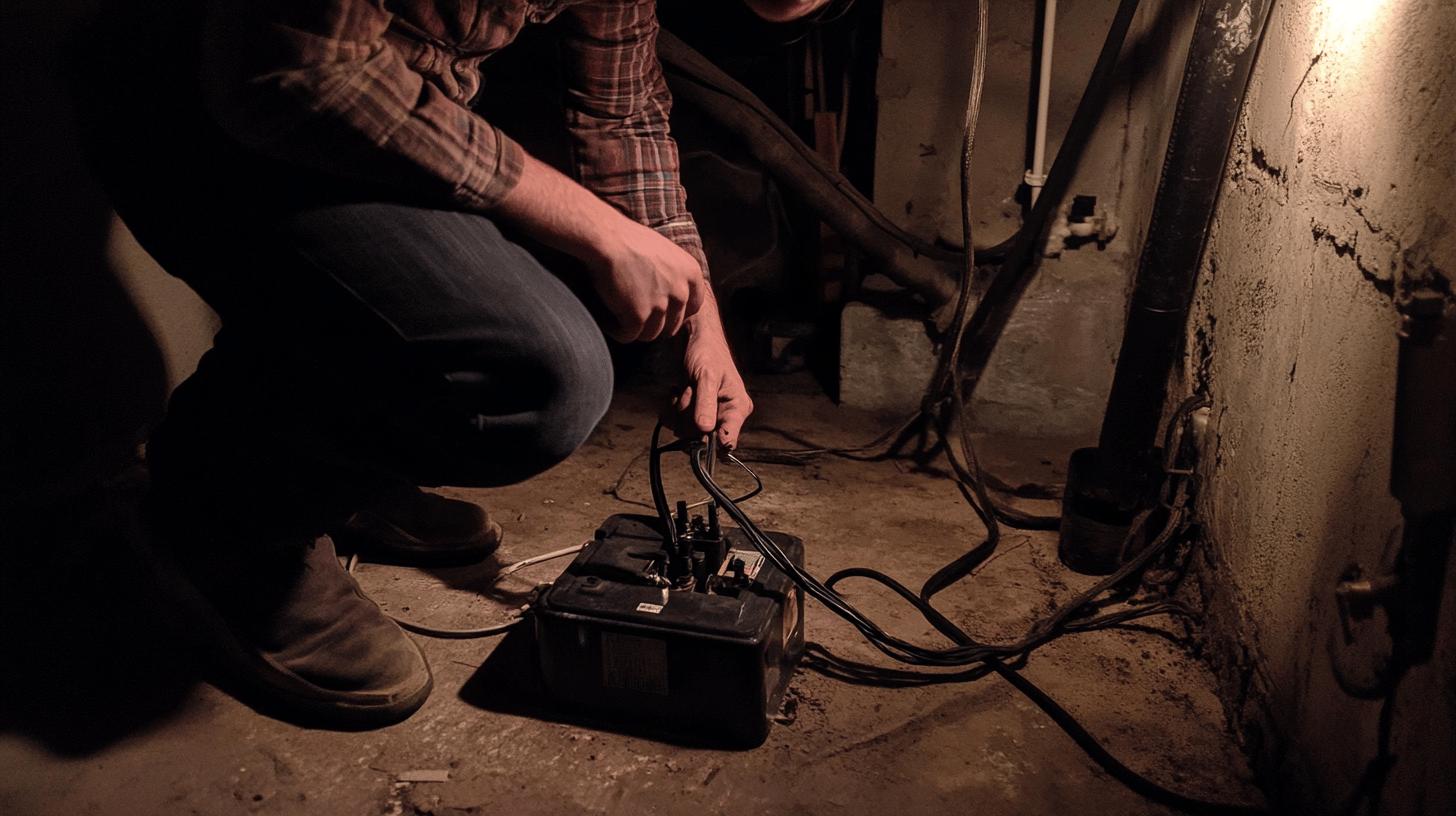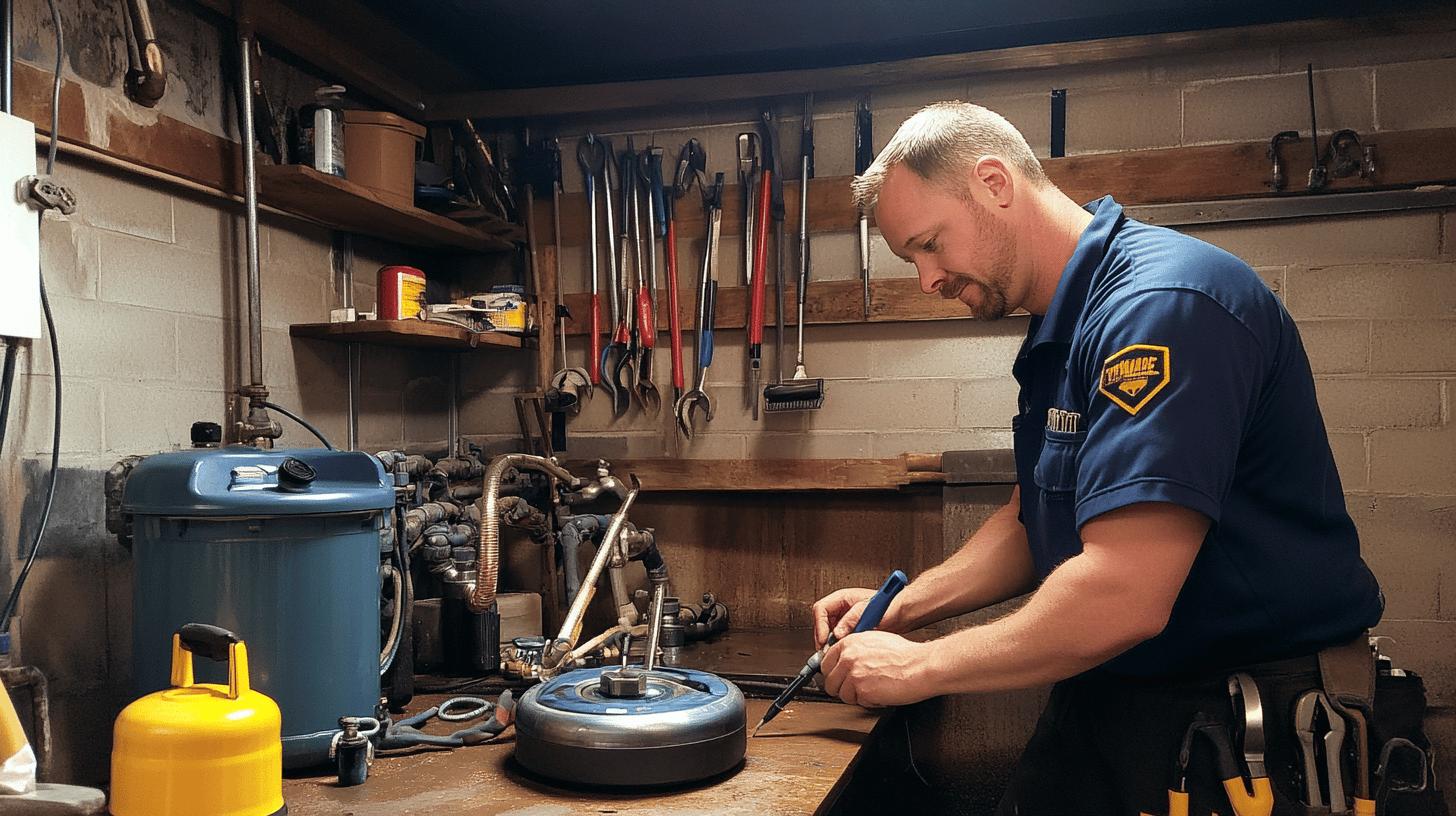TL;DR:
- Common sump pump problems: no water, clogged switches, power loss, frozen discharge lines, improper sizing/installation, lack of maintenance.
- DIY troubleshooting steps: check power supply, test float switch, inspect for clogs, examine for overheating, clean pump.
- Maintenance tasks: pour water monthly, check for leaks quarterly, schedule annual inspection and cleaning.
- Call a plumber if issues persist after basic troubleshooting, or if there are frequent cycling/noises.
- Benefits of hiring a plumber: accurate diagnosis, specialized tools, proper installation, preventive insights, service warranties.
- Key sump pump components: motor (drives impeller), float switch (activates pump), discharge pipe (carries water outside).
Is your basement turning into a mini swimming pool? Fixing sump pump problems quickly can save you from expensive water damage. Whether it’s a clogged switch, power outage, or installation mistake, figuring out what’s wrong is important. This guide will help you spot common sump pump issues and give you easy solutions. Keep reading to learn how some basic knowledge can keep your pump working smoothly, and when you might need to call a pro for bigger fixes. Ready to get your pump working again? Let’s get started!
Diagnosing Common Sump Pump Problems
Catching sump pump problems early is crucial to avoiding expensive water damage. A faulty sump pump can lead to basement flooding and serious damage to your home. Knowing the warning signs of common issues is important. Fixing problems early doesn’t just stop immediate trouble—it also helps your pump last longer. Regular checks and quick fixes will keep your basement dry and your home safe.
Common issues include:
- No water in the sump pit
- Clogged switches
- Power loss
- Frozen discharge lines
- Incorrect pump sizing
- Improper installation
- Lack of regular maintenance
Hiring a professional plumber is usually the best option for sump pump problems. They have the experience and skills that DIY fixes might miss. A pro can quickly figure out whether the issue is electrical, mechanical, or due to bad installation, and they make sure repairs are done right the first time, lowering the chances of future problems.
Plus, hiring a plumber gives you peace of mind. They’ll not only fix the issue but also give you advice on how to prevent it from happening again. Their work often comes with warranties, which is extra assurance for homeowners. Though it may cost more upfront, it can save you money in the long run by preventing recurring problems and keeping your pump running efficiently.
Step-by-Step Guide to Fixing a Sump Pump

Fixing your sump pump takes some know-how and careful attention to common problems. Getting the repair right is important to keep it running smoothly and prevent water damage. Regular testing and maintenance are key to avoiding issues like power outages, clogs, and mechanical breakdowns. If your pump isn’t working, here’s a step-by-step guide to help you fix it:
-
Check the Power Supply: Make sure the pump is plugged in and the breaker is not tripped. Inspect the outlet and cords for any damage.
-
Test the Float Switch: Lift the float switch manually. If the pump doesn’t activate, the switch might be stuck or broken.
-
Inspect for Clogs: Clear any debris from the inlet and discharge pipes so that water can flow easily.
-
Examine for Overheating: If the pump seems overheated, let it cool, then reset it by unplugging and plugging it back in.
-
Clean the Sump Pump: Remove the pump, clean all parts, and ensure it’s free of dirt before reinstalling.
Hiring a professional for complex repairs is a smart move. They have the right tools and expertise to catch problems that might go unnoticed by an untrained eye. Their accurate diagnosis and repairs save you time and money by preventing future breakdowns
Essential Maintenance Tips for Sump Pumps
Proper maintenance keeps your sump pump running smoothly for years. Simple routine tasks can prevent sudden failures and expensive repairs. Regularly inspect the pump by pouring water into the crock during dry spells to make sure it’s working. Pre-season checks also help get the system ready for heavy use during rainy seasons.
Maintaining other plumbing fixtures, such as bathtubs and sinks, helps ease the burden on your sump pump.
| Maintenance Task | Frequency |
|---|---|
| Pour water into sump pit | Monthly |
| Check for leaks and pipe integrity | Quarterly |
| Schedule professional inspection | Annually |
| Clean sump pump and pit | Annually |
Knowing when to call a professional is just as important. While DIY maintenance is helpful, pros can spot hidden issues. If your sump pump makes strange noises, cycles on and off frequently, or runs non-stop, it’s time to get an expert involved. They’ll provide fast, effective fixes that improve your pump’s performance and extend its lifespan.
When to Consult a Professional Plumber

When should you call a professional plumber for sump pump issues? Reach out if your pump still isn’t working after basic troubleshooting, like checking the power, float switch, or clearing blockages. Persistent problems like frequent cycling or strange noises also need expert attention. If the pump is installed incorrectly or the wrong size, a pro can fix it to ensure it runs efficiently.
Benefits of hiring a plumber include:
- Accurate diagnosis of complex problems
- Access to specialized tools and knowledge
- Assurance of proper installation and sizing
- Professional insights for preventing future issues
- Warranty and guarantees on service and parts
Hiring a plumber ensures reliability and peace of mind. Trusting your sump pump to an expert means effective repairs and proper maintenance. Pros not only fix current issues but also help prevent future problems. Plus, service warranties give you extra confidence in their work, protecting your home from water damage and saving you money in the long run.
Understanding Sump Pump Components and Their Functions
Knowing the parts and functions of your sump pump is essential for keeping it working well. Understanding how it all fits together helps you diagnose issues, perform maintenance, and choose a new pump when needed. A sump pump system, whether it’s a primary, backup, or combination pump, plays a crucial role in managing water and preventing flooding and damage to your home. Recognizing its components makes it easier to troubleshoot problems and figure out when to call for professional help.
Key Sump Pump Components
-
Pump Motor: The pump’s heart, driving the impeller to move water out. A good motor ensures optimal performance.
-
Float Switch: It activates the pump as water rises. A stuck or faulty switch can prevent activation, leading to flooding risks.
-
Discharge Pipe: Carries water outside the home. Blocked or frozen pipes can disrupt the pump’s function, causing backups.
By understanding how each component works, you’ll be better equipped to troubleshoot and maintain your sump pump. This knowledge helps you quickly identify issues like a stuck float switch or a clogged pipe so you can take action before things get worse. Regular checks and knowing when to perform maintenance will extend your sump pump’s life, making sure it runs efficiently when you need it most.
Final Words
Getting your sump pump back up and running involves diagnosing common issues, following a step-by-step repair guide, and keeping up with regular maintenance. Spotting problems early—like clogged switches or power loss—can help prevent further damage. Using proper maintenance techniques is crucial for long-lasting performance.
For complex repairs or expert advice, consult a trusted plumber to ensure quality results. Understanding how sump pumps work will help you maintain them better. Taking these steps will make sure your sump pump operates effectively when you need it most, giving you peace of mind during potential flooding situations. By following this approach, you can get your sump pump working efficiently again, protecting your property from water damage.
FAQ
How do I get my sump pump to work again?
If your sump pump is not working, first check for power issues. Ensure it’s plugged in and breakers are not tripped. Inspect for clogs, overheating, or a stuck float switch. Pour water into the pit to see if it activates.
Why is my sump pump not kicking on?
The sump pump may not kick on due to a tripped circuit breaker, a stuck float switch, or clogs in the system. Check these areas to identify and resolve the issue for proper operation.
How do I reset a sump pump?
To reset, unplug the sump pump and plug it back in. If it has a reset button, press it. This often resolves minor glitches in operation, restoring normal function.
What happens if my sump pump stops working?
When a sump pump stops working, it can lead to basement flooding and water damage. Address power issues or mechanical failures promptly to prevent costly damage to your home.
How to make sure your sump pump is working?
Ensure your sump pump’s functionality by periodically pouring water into the sump pit. Ensure it activates and pumps water out efficiently. This regular check helps prevent unexpected failures.
Can you shower if your sump pump is not working?
You can shower if your sump pump is not working, but proceed with caution. The main concern is potential flooding if water use increases sump levels without a functioning pump.
Why is my submersible sump pump not working?
Your submersible sump pump might not work due to issues like power loss, debris blockage, or mechanical failures. Check power supply and clean any debris blocking the inlet or impeller.

